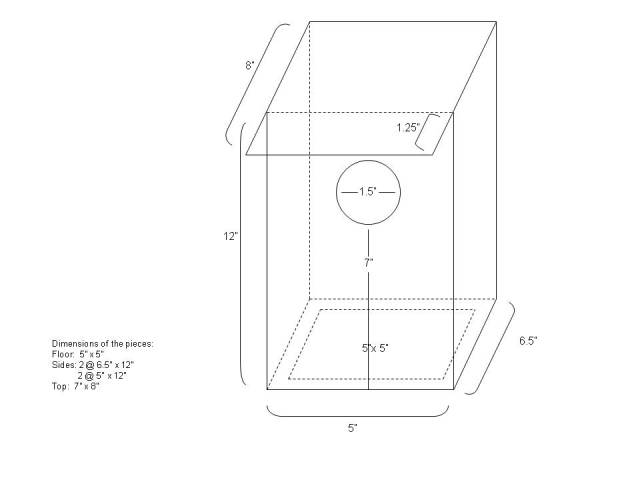On this page, you can find 4 topics: Overview of our nest box style, information about the mounting of the boxes, and links to individual species write-ups. (Click on any of the above links to skip to that section.) If you’d like to see what the nest box environment on our property looks like, you can find that here; click on the “nest box environment” link in the first paragraph. If you’re interested in all sorts of information about nest boxes, be sure to visit this wonderful Web site: http://www.sialis.org. Although it specializes in bluebirds, it covers many, many issues that are important to cavity nesters of all kinds.
In 2008, we had approximately 120 nest boxes on our ~39 acres. We used to offer a variety of sizes and designs; but we found that all of the cavity nesters seemed to prefer one style—-from the tiny Juniper Titmice and Mountain Chickadees to the (relatively speaking) large Ash-throated Flycatchers. So now, nearly all of the nest boxes are variations of the basic NABS nest box, hinged at the top and opening at either the front or the side. These rough dimensions are for a front-opening box, so the front and the back panels are each 5″ wide and the side panels, 6.5″ wide. If you wanted a side-opening box, the 2 sides would be 5″ wide; the front and back, 6.5″ wide. Most boxes are made out of 3/4″ plywood. (Note that, given my meager “drafting” skills, I don’t show the 1/2-inch ventilation space between the roof and the front wall. Also, the roof has an overhang of 1/4″ on each side, which I also don’t depict here.)

nest box dimensions
All boxes face either east or southeast, to avoid the hot afternoon sun and the prevailing winds (from the west) and driving monsoon rains (from the southwest, when we’re lucky). All are hung from trees (mostly pinyon pines, but a few juniper trees), approximately 5 feet above the ground for easy monitoring. If you’re a nest box aficionado, you may know that many people think nest boxes should never be mounted on trees—-too easy for predators to get to them. However, our area is very light on predators; our primary culprits are chipmunks and an occasional snake. We have none of the usual mammal suspects so common elsewhere such as raccoons, tree squirrels, or domestic or feral cats; we have nowhere near the number of crafty snakes that many of the more southerly areas have. We’re also extremely lucky that we don’t have European Starlings, House Wrens, or House Sparrows—-the avian anathemas of cavity nesters.
On the pages listed below, you can see photos and narratives from the nesting season of 2008. (These pages will be works in progress while I recover from the monitoring activities of the summer and catch up on all of the “real” work I neglected in order to do those activities.) You can click on the links below to get to each species’ page. (As a page is finished and published, I’ll add the link.)
We also have stumbled across some surprises in the process of monitoring the nest boxes:
© 2010 Tina Mitchell



Violet-Greens have about disappeared from the Columbia Falls, MT area of NW Montana. Four years ago we had an abundance of TRES and VGSWs. Three years ago we had a long cold period after the swallows arrived in early April. I had only one nesting pair of TRES that survived. I found TRES dead in their nesting boxes and no VGSWs around at all. Have only had one nesting pair of TRES the last 2 years and the sparrows are taking over my 6 swallow boxes. Finally, one pair of TRES raised 4 young with my help by letting the sparrows have 3 boxes and then destroying their eggs (24 total).
In our area the VGSWs like a straight in box with no drop. They make many nests in lumber mill yards that have lots of stacks of lumber separated by stickers for drying. For several years I had a pair of VGSWs in my straight in box on an upright of my upper deck. The cold weather of that bad year seemed to eliminate most all VGSWs in the Columbia Falls area. I have seen very few TRES and NO VGSWs since. They used to be all over the town and I could see them whenever I drove through the main part of town. Last year I even lost a pair of TRES to Merlin hawks. Damn, those birds fly fast and can maneuver!